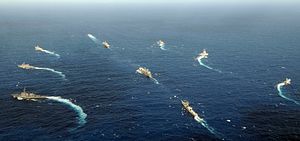New configurations in Asian geopolitics are emerging thick and fast. Last month saw the initiative of a new trilateral involving India, Japan, and Australia when Indian Foreign Secretary S. Jaishankar met his Australian counterpart and the Japanese vice foreign minister. Japan will also be a part of bilateral India-U.S. annual naval exercises–the Malabar–slated to be held over the next few months. Though Japan has participated in these exercises in the past as well, this will be only the second time when Japan will join these exercises in the geostrategically critical Indian Ocean region.
There is a growing convergence in the region now that the strategic framework of the Indo-Pacific remains the best way forward to manage the rapidly shifting contours of Asia. Proposed first by Japan and adopted with enthusiasm by Australia under the Tony Abbott government, in particular, the framework has gained considerable currency, with even the U.S. now increasingly articulating the need for it. Though China views the framework with suspicion, many in China are acknowledging that the Indo-Pacific has emerged as a critical regional space for India and China needs to synchronize its policies across the Indian Ocean region and the Pacific.
These developments underscore the changing regional configuration in the Indo-Pacific on account of China’s aggressive foreign policy posture as well as a new seriousness in India’s own China policy. Indian Prime Minister Narendra Modi’s outreach to Japan and Australia has been a significant part of his government’s foreign policy so far as strong security ties with Tokyo and Canberra are now viewed as vital by Delhi.
China’s increasing diplomatic and economic influence, coupled with domestic nationalistic demands, has led to an adjustment of its military power and the adoption of a bolder and more proactive foreign policy. From China’s unilateral decision in 2013 to extend its air defense identification zone (ADIZ) over a contested maritime area in the East China Sea overlapping with the already existing Japanese ADIZ to announcing new fishing regulations for Hainan province in January 2014 to ensure that all foreign vessels need fishing permits from Hainan authorities to operate in more than half of South China Sea, the list of assertive moves has been growing in recent years. China’s land reclamation work in the Spratly Islands has been the most dramatic affirmation of Beijing’s desire to change the ground realities in the region in its favor. This has generated apprehensions about a growing void in the region to balance China’s growing dominance.
With the U.S. consumed by its own domestic vulnerabilities and never ending crises in the Middle East, regional powers such as India, Japan, and Australia have been more proactive than in the past in managing this turbulence. The new trilaterals emerging in Asia go beyond past attempts at rudimentary joint military exercises. In December 2013, the Japanese Maritime Self-Defense Force (JMSDF) conducted its first bilateral maritime exercise with the Indian Navy in the Indian Ocean Region. With growing strategic convergence between the two, in 2014 India invited the JMSDF to participate in the annual Malabar exercises with the U.S. Navy in the Pacific waters.
India and Japan have an institutionalized trilateral strategic dialogue partnership with the United States, initiated in 2011. Maintaining a balance of power in the Asian-Pacific as well as maritime security in the Indo-Pacific waters has become an important element of this dialogue. A similar dialogue exists between the U.S., Japan, and Australia. And now a new trilateral involving India, Japan, and Australia has joined these initiatives, which can potentially to transform into a ‘quad’ of democracies in the Indo-Pacific region. The roots of this potential partnership were laid as early as late-2004, when navies from the U.S., India, Japan, and Australia collaborated in tsunami relief operations all across the Indian Ocean.
Japan was one of the earliest vocal supporters of such initiatives. In 2007, Japanese Prime Minister Shinzo Abe, in his earlier stint as prime minister, lobbied for Asia’s democracies to come together in a ‘quadrilateral.’ This was also actively supported by the United States. Such an initiative resulted in a five nation naval exercise in Bay of Bengal in September 2007. However, China, perceiving a possible ganging-up of Asia’s democracies, issued demarches to New Delhi and Canberra, causing this initiative to lose steam, since both Australia and New Delhi felt it unwise to provoke China. However, as China becomes more aggressive in the region, there are signs that India and Australia may be warming up to the idea again.
The uncertainty of Chinese power and intentions in the region as well as the future of American commitment to maintaining the balance of power in Asia rank high in the strategic thinking of regional powers. This rapidly evolving regional geopolitics is forcing Asia’s middle powers – India, Japan and Australia – to devise alternative strategies for balancing China. Though still continuing their security partnership with the United States, these powers are actively hedging against the possibility of America’s failure to eventually balance China’s growing power. Asia’s geopolitical space is undergoing a transformation. While China’s rise is the biggest story still unfolding, other powers are also recalibrating and their influence will be of equal, if not greater, consequence in shaping the future of global politics in the Asia-Pacific.

































